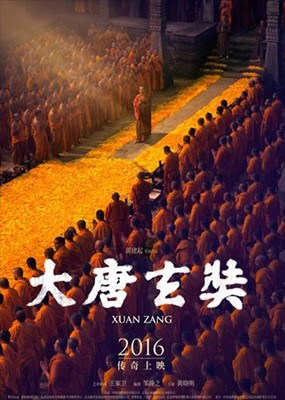
A still from Xuan Zang (Photo/Courtesy of China Film Group Corporation)
Seen again and again in TV series, movies and animation, Journey to the West by Ming Dynasty (1368-1644) writer Wu Cheng'en is probably one of the most commonly adapted stories in China and has therefore exerted great influence on different generations of Chinese's impressions of the Buddhist monk Xuanzang (c. 602-664), the real life monk upon which the Tang Monk character in the novel was based.
Despite its broad and permeating influence in society, the weak and delicate portrayal of Tang Monk in Journey to the West is rather misleading when it comes to introducing this historic figure. Spending 19 years traveling to, studying at and returning from the Nalanda Monastery in India, Xuan Zang is probably one of the most famous monks of the Tang Dynasty (618-907).
A new co-production between China and India, Xuan Zang, directed by Chinese director Huo Jianqi and starring Huang Xiaoming as Xuan Zang as well as Indian actors and actresses, aims to reveal the real Xuan Zang and his arduous journey to India to audiences this year.
At a press conference for the film on Tuesday in Qingdao, Shandong Province, the film crew shared their experiences shooting in the film in China and India and their unexpected discovery of the revered monk's legacy in the place where he once sought enlightenment.
Unaccompanied and lacking even a compass, Xuan Zang's journey through the desert in what is now the Xinjiang Uyghur Autonomous Region was probably the most difficult part of his pilgrimage to the West. For this reason, Huo emphasized shooting a large part of the film in the desert.
"These extremely difficult conditions underscored his persistence in his beliefs," Huo said.
"There were many different versions of Buddhist scriptures in China at the time, which was very confusing for him. Hearing about the existence of a huge and holy monastery in India, he decided to bring authentic scriptures back to China," Huo told the Global Times.
Although his travels lack the various monsters that are depicted in Journey to the West, Xuan Zang's journey was still full of life-threatening obstacles, including the natural, like the desert, and man-made, such as when a local governor tried to stop him from leaving the country.
"His identity at the time meant he was not allowed to leave the country," Huo added.
"This is definitely one of the most difficult roles I've played," said Huang.
"We often had to move to different areas of the desert for scenes and I had to carry this really heavy knapsack." Basically a one-man-show that heavily emphasizes the psychology of the main character, the film was challenging for Huang, an actor who has been seen as getting by with his looks.
To stay as close to historical reality, sections of the film were shot in India. After arriving in ancient India, Xuan Zang didn't just study Buddhist scriptures, but traveled across the region, speaking with local people and taking note on Buddhism's influence on people's lives.
He took notes wherever he went, and these would later become the Great Tang Records on the Western Regions, which contains information on the many different sides of Indian society at the time, such as its geography, politics, taxes and language.
"It's only when you get to the country (India), that you can really feel his influence and local people's familiarity with Xuan Zang. His story is in the textbooks of local primary and middle school students," said Huo.
One of three films being made as part of the Sino-India Film Cooperation launched in May, Xuan Zang is expected to premiere in China and India sometime during the first half of 2016.


















































